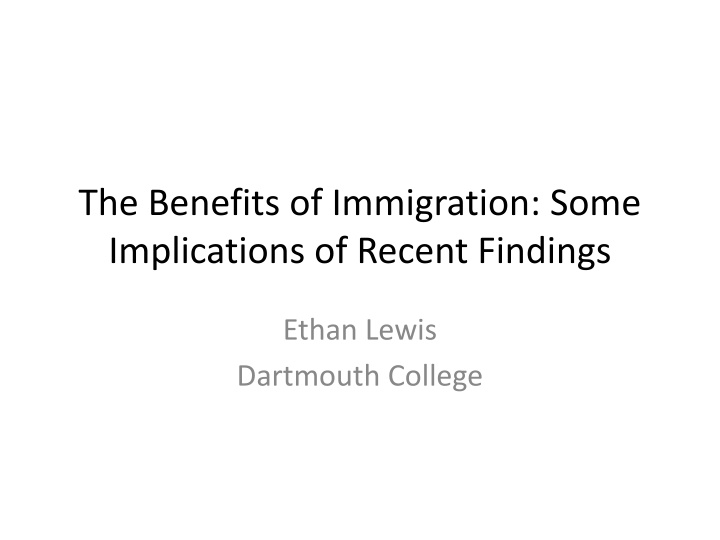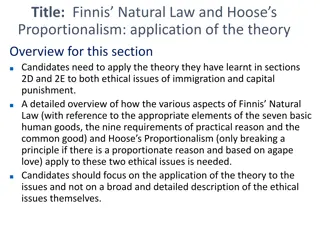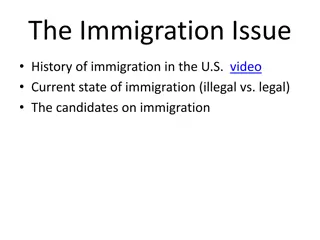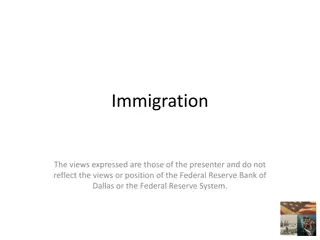The Benefits of Immigration: Recent Findings and Implications
Recent research highlights the significant benefits of immigration, with gains for immigrants themselves and potential positive impacts on the host country's wage structure. While the benefits to the receiving country are relatively small, the impact on wage distribution is crucial. Data from the United States and the United Kingdom in the 1990s shed light on the educational levels of immigrants and existing workers, emphasizing the importance of skills distribution.
Uploaded on Oct 09, 2024 | 0 Views
Download Presentation

Please find below an Image/Link to download the presentation.
The content on the website is provided AS IS for your information and personal use only. It may not be sold, licensed, or shared on other websites without obtaining consent from the author.If you encounter any issues during the download, it is possible that the publisher has removed the file from their server.
You are allowed to download the files provided on this website for personal or commercial use, subject to the condition that they are used lawfully. All files are the property of their respective owners.
The content on the website is provided AS IS for your information and personal use only. It may not be sold, licensed, or shared on other websites without obtaining consent from the author.
E N D
Presentation Transcript
The Benefits of Immigration: Some Implications of Recent Findings Ethan Lewis Dartmouth College
The Standard Model Gains to immigrants themselves are huge Large cross-country income differences persist The world would benefit from a much freer immigration system (e.g., Hamilton and Whalley 1984, Kennan 2013) Gains to receiving country are comparatively small, and contingent on much larger distributional impacts (e.g., Borjas, 1999) Typical estimate of net benefit: Well <1% of GDP.
The Standard Model Immigration produces benefits by tilting the wage structure: A country gains the most from immigration when it admits immigrants with scarce skills: those skills which are rarest in the existing population This lowers the wage of those scarce skill, but raises the wage of everyone else (the commoner skill) and on average natives benefit There are winners and losers A skill-balanced inflow produces no long-run benefits Perhaps a (very) short run benefit for native capital owners
United States, 2000 Percent College and Non-College, 1990s Immigrants and Existing Workers 100 1990s Immigrants Existing Workers 80 60 55.4 52.0 48.0 44.6 40 20 0 Non-College College Data Source: Docquier, Ozden, and Peri (2010)
United States, 2000 Percent at Five Education Levels among 1990s Immigrants and Existing Workers 50 1990s Immigrants Existing Workers 42.0 40 30.5 30 28.0 19.3 20 17.8 16.3 15.7 13.0 9.5 10 8.0 0 Dropout HS Grad 1-3 Yrs Coll 4 yrs Coll Adv. Degree Data Source: 2000 Census of Population
United Kingdom, 2000 Percent College and Non-College, 1990s Immigrants and Existing Workers, 2000 100 1990s Immigrants Existing Workers 84.2 81.3 80 60 40 18.7 20 15.8 0 Non-College College Data Source: Docquier, Ozden, and Peri (2010)
Percent College and Non-College, 1990s Immigrants and Existing Workers, 2000 United States United Kingdom Canada Sweden 100 100 100 100 80 80 80 80 60 60 60 60 40 40 40 40 20 20 20 20 0 0 0 0 Non-College College Non-College College Non-College College Non-College College France Germany Netherlands Belgium 100 100 100 100 80 80 80 80 60 60 60 60 40 40 40 40 20 20 20 20 0 0 0 0 Non-College College Non-College College Non-College College Non-College College Greece Italy Spain Portugal 100 100 100 100 80 80 80 80 60 60 60 60 40 40 40 40 20 20 20 20 0 0 0 0 Non-College College Non-College College Non-College College Non-College College Data Source: Docquier, Ozden, and Peri (2010)
The standard model: whats missing? Factors which make benefits larger: Imperfect substitutability between immigrants and natives in the same observable skill group s natives gains from immigration: adverse distributional consequences are borne more by immigrants themselves Related: gains from product variety Productivity spillovers Factors which (generally) make benefits smaller: Long-run adjustments in production technology Non-wage impacts: public goods, compositional amenities
Gains from Variety Immigrants increase variety of goods & svcs More small firms (Olney, 2013), ethnic diversity in restaurants (Mazzolari and Neumark, 2012) though perhaps more big-box retailers Hedonic value (Ottaviano and Peri, 2006) Another mechanism: scale effects increase the extent of the product market Large effects from scale effects of immigration, e.g., 5% of GDP in U.S. (di Giovanni et al., 2013)
Productivity Spillovers High skill H1-B (type of US visa) immigrants may raise productivity by e.g., generating new ideas H1-B immigrants have high patent rates, induce more patents from native-born: Hunt & Gauthier-Loiselle (2010), Kerr & Lincoln (2010) Link to productivity? HGL say may have d GDP 2% in the 1990s (applying est s from Furman et al. 2002) Direct association between H1-B induced increase in science workers and productivity across U.S. metro areas (Peri et al., 2013) 1990-2000: TFP 3.8%; higher college, but not non- college wages
Spillovers, but But Paserman (2013) finds no evidence of productivity spillovers in Israel following the influx of former Soviet Union immigrants He looks across industries and firms Some evidence that high-tech sectors benefitted Misses aggregate effects? Israel too far from the technological frontier?
Spillovers, but A concern: spillover model may be symmetrically used to argue that unskilled immigration harms productivity: ??????? ln ???????????? = ? + ? ??????? + ????????? (e.g., Moretti, 2004) But: Results sensitive, especially to who is unskilled Acemoglu and Angrist (2000), Sand(2007), Iranzo&Peri (2009) Don t forget: unskilled immigration is the source of benefits in standard model (in the US) Indeed: in the U.S., immigration is associated with faster wage growth, despite reducing college share: e.g., Peri(2012)
Immigration Lowers College Share but Raises Wages United States Metropolitan Areas, 2000-2010 Adjusted Wage Growth, Native-Born* Change in College Share .15 .2 .1 .1 .05 0 -.1 0 -.05 -.2 -.02 0 .02 .04 .06 .08 -.02 0 .02 .04 .06 .08 more Change in Share Foreign-Born, 2000-2010 Data Sources: 2000 Census of Population and 2009-2011 American Community Surveys. *Change in Mean ln(hourly wages) of native born regression adjusted for experience, education, race and gender separately in 2000 and 2010. Change in Share Foreign-Born, 2000-2010
Other factors not in standard model Entrepreneurship: immigrants have high rates May also have productivity benefits Long run adjustments in production techn. Public goods
Conclusions Standard model: immigration has benefits, but come with larger distributional consequences Benefits largest from immigrants with skill that are scarce in the native population (low-skill in US) Standard model leaves out many things, some of which may dwarf benefits in stand. model Although more research supporting this claim would be helpful
Imperfect Substitutability - details
Imperfect Substitutability Imms & natives are imperfect substitutes = wage gap between them responds to their relative #s* In U.S. appears tied to English language skills: Immigrants w/strong English much closer substitutes for natives (Lewis, 2011) Immigrants and natives specialize in different jobs Natives specialize in jobs which require communication (Peri & Sparber, 2009) and benefit from lower cost of low-skill svcs (Cortes, 2008) This increases natives net gains from immigration, as adverse distributional consequences are borne more by the immigrants themselves * e.g., Ottaviano and Peri, 2012. Back
Imperfect Substitutability ln(Wage Gap) between similar Immigrants and Natives, by Immigrants' English Skills Immigrants Fluent in English Immigrants with no English 1 1 Immigrant-Native ln Wage Gap .5 .5 0 0 -.5 -.5 -1 -1 -4 -3 -2 -1 0 1 -4 -3 -2 -1 0 1 Ln(Immigrant/Native) Total Hours Ln(Immigrant/Native) Total Hours Data sources: 2000 Census of Population and 2007-9 American Community Surveys. Each dot represents a metropolitan area x broad education (college/non-college) x year cell. Wage gaps computed w/in narrow experience x education cells. Regression adjusted for education x year dummies. Back to language skills Back to what s missing
Aggregate Trends in Israel, Before and after FSU Immigration
ln GDP per capita*: Israel and Synthetic Control**, before and after fall of Soviet Union .3 Israel Synthethic Control** ln(GDP per Capita) relative to 1988 .2 .1 0 -.1 -.2 1980 1985 1990 1995 2000 2005 Data souce: World Development Indicators. *In constant U.S. dollars, deviations from 1988 value. **Combination of OECD countries matched on GDP/cap in 1978-1989, education, and openness. Largest weights on Belgium (37%), New Zealand (35%), Finland(13%), and US(8%). back
Ln(Patents/Capita)*: Israel and Synthetic Control**, before and after fall of Soviet Union -11.8 Israel Synthethic Control** ln(Patents Per Working Age Population) -12 -12.2 -12.4 -12.6 -12.8 1980 1985 1990 1995 2000 2005 Data souce: World Development Indicators. *ln(Patents/Working Age Population) **Combination of OECD countries matched on patents/Capita 1978,84,89; GDP/capita in 1989; and education. Largest weights are: US(41%), UK(32%), Korea(15%), New Zealand(7%).
Investment/GDP: Israel and Synthetic Control*, before and after fall of Soviet Union Israel Synthethic Control* 28 26 Investment/GDP 24 22 20 18 1980 Data souce: Penn World Tables and World Development Indicators. *Combination of OECD countries matched on investment/GDP 1980-89, GDP/cap in 1989, openness, and real interest rate. Largest weights are: Ireland(39%), US(39%), Chile(21%). 1985 1990 1995 2000 2005 back
ln GDP per capita*: Israel and OECD, before and after fall of Soviet Union .3 Israel OECD ln(GDP per Capita) relative to 1988 .2 .1 0 -.1 -.2 1980 1985 1990 1995 2000 2005 year Data souce: World Development Indicators. *In constant U.S. dollars, deviations from 1988 value back
More Native Wage Growth Results
Immigration Lowers College Share but Raises Wages United States Metropolitan Areas, 2000-2010, Versus Ethnic Enclave Instrument Adjusted Wage Growth, Native-Born* Change in College Share .15 .2 .1 .1 .05 0 -.1 0 -.05 -.2 0 .05 .1 .15 .2 0 .05 .1 .15 .2 Ethnic Enclave Instrument: Change in Predicted Share Foreign-Born, 2000-2010 Data Sources: 2000 Census of Population and 2009-2011 American Community Surveys. *Change in Mean ln(hourly wages) of native born regression adjusted for experience, education, race and gender separately in 2000 and 2010. Back
First Stage: Change in Immigrant Share vs. Ethnic Enclave Instrument United States Metropolitan Areas, 2000-2010 .08 .06 .04 .02 0 -.02 0 .05 .1 .15 .2 Ethnic Enclave Instrument: Change in Predicted Share Foreign-Born, 2000-2010 Data Sources: 2000 Census of Population and 2009-2011 American Community Surveys.
Adjusted Wage Growth, Native-Born, by College/Non-College* United States Metropolitan Areas, 2000-2010, Versus Ethnic Enclave Instrument Native-Born College-Educated Native-Born Non-College-Educated .2 .2 .1 .1 0 0 -.1 -.1 -.2 -.2 0 .05 .1 .15 .2 0 .05 .1 .15 .2 Ethnic Enclave Instrument: Change in Predicted Share Foreign-Born, 2000-2010 Data Sources: 2000 Census of Population and 2009-2011 American Community Surveys. *Change in Mean ln(hourly wages) of native born regression adjusted for experience, education, race and gender separately in 2000 and 2010. Back
Immigrant Entrepreneurship Entrepreneurial ability or willingness to take risks may be another scarce skill that immigrants bring, with productivity benefits Imms more likely to start businesses (eg, Hunt 2011) Hunt studied college educated imms, but imms have high entrepreneurship rates at all education levels Raises productivity? Immigrant-owned businesses have 12% more revenue/worker than native-owned businesses (Garcia-Perez, 2008) Also, business turnover accounts for a large fraction of productivity growth (e.g., Haltiwanger 2009)
Self-Employment Rates by Nativity and Education United States, 2010-12 9.86 10 Immigrants Native-born 8.87 7.62 8 7.51 6.72 6.69 6.68 6.22 6.09 6 5.17 4 2 0 Dropout HS Grad 1-3 Yrs Coll 4 yrs Coll Adv. Degree Data Source: 2010-12 March Current Population Surveys. NOTE: Lawyers, doctors, taxi drivers, and construcion workers not counted as self-employed in this figure. back
Details: Characteristics of Immigrant-Owned Businesses
Percent in Each Revenue Category by Nativity of Business Owner, 1992 Foreign-Born Owner Native-Born Owner 30 20 10 0 $0-$4,999 >$1,000,000 $5,000-$9,999 $100,000-$199,999 $200,000-$249,999 $250,000-$499,999 $500,000-$999,999 $10,000-$24,999 $25,000-$49,999 $50,000-$99,999 Data Source: US Department of Commerce, Bureau of the Census. Characteristics of Business Owners. CBO92-1, Washington, DC: US Government Printing Office. September 1997. Table 6b.
Percent in Each Employment Category at Employer Businesses, by Nativity of Business Owner, 1992 80 Foreign-Born Owner Native-Born Owner 60 Foreign-Born: 82.4% Non-Employer Native-Born : 84.7% Non-Employer 40 20 0 1-4 Emp 5-9 Emp 10-19 Emp 20-49 Emp 50-99 Emp >100 Emp Data Source: US Department of Commerce, Bureau of the Census. Characteristics of Business Owners. CBO92-1, Washington, DC: US Government Printing Office. September 1997. Table 6c. back
The Long Run In the long-run, adjustments in production tech may diminish adverse distributional impacts of immigration (Lewis, 2013) In response to unskilled imm, shift to (Beaudry & Green 2003, 2005) or develop (Acemoglu 1998, 2002) more unskilled production technology Other mechanisms: capital adjustments under capital- skill complementarity; adjustments in product mix Also implies that benefits will diminish over time back
Public goods Likely animates much of the opposition to immigration, rather than labor market impacts Natives reveal a strong distaste for living in neighborhoods (Saez & Wachter, 2011), sending children to school w/imms (Cascio & Lewis, 2012) Also, some benefits (social security solvency) Needs more research Natives may have an exaggeratedly negative view of immigrants impact on public goods back
Sources Cited Many of the ideas in this article derive from Lewis E. 2013. Immigration and Production Technology. Annual Review of Economics 5. The standard model is well described in: Borjas, GJ. 1999. The Economic Analysis of Immigration. In Handbook of Labor Economics Volume 3A, ed. O. Ashenfelter and D. Card, pp. 1697-1760. Amsterdam: Elsevier. Other sources include: Acemoglu D. 1998. Why do new technologies complement skills? Directed technical change and wage inequality. Q. J. Econ. 113:1055 89 Acemoglu D. 2002. Technical change, inequality and the labor market. J. Econ. Lit. 40:7 72 Acemoglu D, Angrist J. 2000. How large are human capital externalities? Evidence from compulsory schooling laws. In NBER Macroeconomics Annual, ed. BS Bernanke, K Rogoff, pp. 9 74. Cambridge, MA: MIT Press Beaudry P, Green DA. 2003. Wages and employment in the United States and Germany: What explains the differences? Am. Econ. Rev. 93:573 602 Beaudry P, Green DA. 2005. Changes in U.S. wages, 1976 2000: ongoing skill bias or major technological change? J. Labor Econ. 23:609 48 Cascio, EU and Lewis, EG. 2012. Cracks In the Melting Pot: Immigration, School Choice, and Segregation. Am. Econ J. Econ. Pol. 4: 91-117
Sources Cited (2) Cortes P. 2008. The effect of low-skilled immigration on US prices: evidence from CPI data. J. Polit. Econ. 116:381 422 di Giovanni J, Levchenko A, Ortega F. 2013. A Global View of Cross-border Migration. Unpublished Manuscript, International Monetary Fund Dustmann C, Frattini T, and Preston I. 2013. The Effect of Immigration along the Distribution of Wages. Rev. Econ. Stud., forthcoming. Eaton J, Kortum S. 1996. Trade in ideas: patenting and productivity in the OECD. J. Int. Econ. 40:251 78 Furman JL, Porter ME, Stern S. 2002. The determinants of national innovative capacity. Res. Policy 31:899 933 Garcia-Perez M. 2008. Does it matter who I work for and who I work with? The impact of owners and coworkers on hiring and wages. Unpublished manuscript, Univ. Maryland, College Park Haltiwanger, J. 2009. Entrepreneurship and Job Growth. In Entrepreneurship, Growth and Public Policy, ed. ZJ Acs, DB Audretsch, RJ Strom, pp. 119-145. Cambridge: Cambridge Univ. Press Hamilton B, Whalley J. 1984. Efficiency and Distributional Implications of Global Restrictions on Labour Mobility: Calculations and Policy Implications. J. Dev. Econ. 14: 61-75. Hunt J. 2011. Which immigrants are most innovative and entrepreneurial? Distinctions by entry visa. J. Labor Econ. 29:417 57 Hunt J, Gauthier-Loiselle M. 2010. How much does immigration boost innovation? Am. Econ. J.Macroecon. 2:31 56 Iranzo S, Peri G. 2009. Schooling externalities, technology, and productivity: theory and evidence from U.S. states. Rev. Econ. Stat. 91:420 31 Kennan, J. 2013. Open Borders. Rev. Econ. Dyn., forthcoming.
Sources Cited (3) Lewis E. 2011. Immigrant-native substitutability: the role of language ability. NBER Work. Pap. 17609 Mazzolari F, Neumark D. 2012. Immigration and Product Diversity. J. Pop. Econ. 25: 1107-1137. Moretti E. 2004. Estimating the social return to higher education: evidence from longitudinal and repeated cross- sectional data. J. Econom. 121:175 212 Olney W. 2013. Immigration and Firm Expansion. J. Reg. Science 53: 142-157 Ottaviano G, Peri G. 2006. The Economic Value of Cultural Diversity: Evidence from U.S. Cities. J. Econ. Geography 6: 9-44. Ottaviano G, Peri G. 2012. Rethinking the Effects of Immigration on Wages. J. Eur. Econ. Assoc. 10: 152-197 Paserman DM. 2013. Do high-skill immigrants raise productivity? Evidence from Israeli manufacturing firms, 1990 1999. Unpublished manuscript, Boston Univ. Peri G. 2012. The effect of immigration on productivity: evidence from U.S. states. Rev. Econ. Stat. 94:348 58 Peri G, Shih K, Sparber CS. 2013. STEM Workers, H1B Visas, and Productivity in US Cities. Unpublished manuscript, University of California Davis Peri G, Sparber CS. 2009. Task specialization, immigration, and wages. Am. Econ. J. Appl. Econ. 1:135 69 Saez A, Wachter S. 2011. Immigration and the Neighborhood. Am Econ. J. Econ. Pol. 3:169-188 Sand B. 2007. Has there been a structural change in the labor market? Evidence from U.S. cities. Unpublished manuscript, Univ. British Columbia, Vancouver
Sources Cited (4) US Department of Commerce, Bureau of the Census. 1997. Characteristics of Business Owners. CBO92-1. Washington, DC: United States Government Printing Office.























